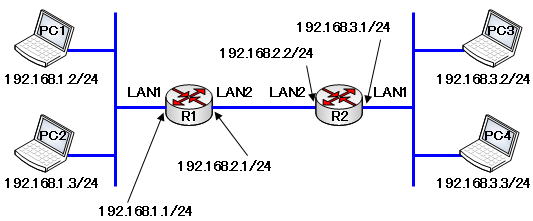QoS設定例・特定のホストに帯域を確保する
ここでは、特定のホストのパケットに帯域幅を確保する設定例を紹介します。
ネットワークの構成は、下図の通りです。

PC1の通信に帯域の80%、その他の通信に20%を割り当てるように帯域制御の設定を行います。
●R1ルータの設定
まずは、R1ルータの基本設定を行います。
# console prompt R1
R1# ip lan1 address 192.168.1.1/24
R1# ip lan2 address 192.168.2.1/24
R1# ip route default gateway 192.168.2.2
キュータイプを指定します。lan2に帯域制御を指定します。
キュータイプにはCBQを指定します。CBQでは、トラフィックをクラス分けすることにより、クラスに応じて、予約帯域割合を設定することで、クラスに設定した重みに応じてパケットを送信します。
R1# queue lan2 type cbq
LAN2に回線速度を指定します。この値を元に帯域が計算されます。
R1# speed lan2 100m
PC1から送信するパケットをクラス1とするフィルタを定義します。通過するパケットは、このフィルタと比較されてクラス分けが行われます。
帯域制御の場合、クラス間に優先順位はありません。つまり、クラスの順位によって帯域が決まるというようなことはありません。帯域制御では、各クラスの各々に帯域を確保してゆきます。
各クラスの属性は、「queue lan2 class property」コマンドで定義します。
R1# queue class filter 1 1 ip 192.168.1.2 * * * *
クラス1のパケットに帯域の80%を確保します。
R1# queue lan2 class property 1 bandwidth=80%
フィルタにマッチしないパケット、デフォルトではクラス2となります。このデフォルトのクラスに残りの帯域の20%を確保します。デフォルトのクラスは「queue lan2 default class 」で変更することができます。
R1# queue lan2 class property 2 bandwidth=20%
フィルタをLAN2インターフェイスに適用します。
R1# queue lan2 class filter list 1
●R2ルータの設定
R2ルータの基本設定を行います。
# console prompt R2
R2# ip lan1 address 192.168.3.1/24
R2# ip lan2 address 192.168.2.2/24
R2# ip route default gateway 192.168.2.1
キュータイプを指定します。lan2に帯域制御を指定します。キュータイプにはCBQを指定します。
R2# queue lan2 type cbq
LAN2に回線速度を指定します。この値を元に帯域が計算されます。
R2# speed lan2 100m
PC1から送信するパケットをクラス1とするフィルタを定義します。通過するパケットは、このフィルタと比較されてクラス分けが行われます。
R2# queue class filter 1 1 ip * 192.168.1.2 * * *
クラス1のパケットに帯域の80%を確保します。
R2# queue lan2 class property 1 bandwidth=80%
フィルタにマッチしないパケット、デフォルトではクラス2となります。このデフォルトのクラスに残りの帯域の20%を確保します。
R2# queue lan2 class property 2 bandwidth=20%
フィルタをLAN2インターフェイスに適用します。
R2# queue lan2 class filter list 1
